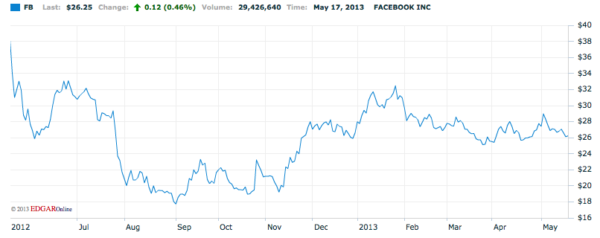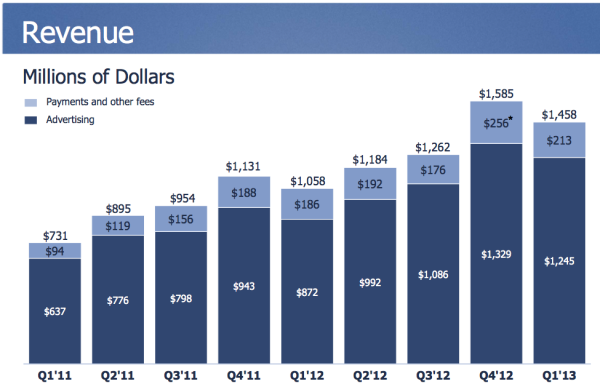After The IPO: Facebook Survives Its “Year Of Living Dangerously”
Yesterday was the one-year anniversary of Facebook’s public offering. It has arguably been the most volatile and momentous period in the company’s roughly eight-and-a-half year history. Facebook went public in May of last year at $38 and closed Friday at just over $26. The low, last September, was $17.55. The volatility of the stock and […]

Facebook went public in May of last year at $38 and closed Friday at just over $26. The low, last September, was $17.55.
The volatility of the stock and the fact that it hasn’t fully returned to its offering price may give many institutional investors reason to complain; but, most other statistics and metrics are up from a year ago. For example, Facebook has impressively been able to grow its mobile revenues in just 12 months from essentially zero to 30 percent of total ad revenue.
Source: Edgar
In May 2012, at the time of the IPO, the following were the key metrics and user numbers:
- 845 million monthly active users
- 483 million daily active users
- 425 million mobile active users
- Total revenue: $1.06 billion
- Ad revenue: $872 million
- Market capitalization: $104 billion
As of March 2013 the same categories looked like this:
- 1.11 billion monthly active users (23 percent growth YoY)
- 655 million daily active users (26 percent growth YoY)
- 751 million mobile active users (54 percent growth YoY)
- Total revenue: $1.458 billion
- Ad revenue: $1.245 billion; mobile revenue was just over $370 million or 30 percent of total ad revenue
- Market capitalization: $68.4 billion
Source: Facebook
As mentioned, the mobile ad figures in particular, as well as Facebook’s ability to grow them so quickly, are impressive. The company clearly “got” Wall Street’s message that it was concerned about the company’s capacity to generate mobile revenue. Facebook is essentially second (though a distant second) to Google in US mobile advertising.
The following are some significant Facebook milestones and announcements since the time period surrounding the IPO last year:
- March 2012: Facebook introduces ads into mobile News Feed
- April 2012: Facebook acquires Instagram in a cash + stock deal worth roughly $1 billion
- May 2012: General Motors withdraws $10 million worth of ads from Facebook
- September 2012: Facebook introduces “Custom Audiences” ad product
- October 2012: Facebook reaches 1 billion users globally
- October 2012: Facebook introduces Facebook ad exchange (FBX)
- December 2012: Average of 350 million photos per day uploaded; 50 million Pages with 10 or more Likes
- January 2013: Facebook Graph Search launches
- April 2013: Facebook changes mobile feature “Nearby” into “Local Search”
- April 2013: General Motors starts advertising again on Facebook
- April 2013: Facebook introduces Home Android home screen experience (reviews are mixed-to-negative)
- May 2013: Facebook Home crosses 1 million downloads threshold in one month, increases engagement by 25 percent
After several uncertain and rocky months, the company now appears on course in its effort to transform from an entertainment and communications tool to a “utility” essential to people’s daily lives and routines. While it still faces threats and has vulnerabilities, among all the major internet companies outside of Google, Facebook is probably in the strongest position, and right now, the only real counterweight to Mountain View.
Opinions expressed in this article are those of the guest author and not necessarily MarTech. Staff authors are listed here.
Related stories

